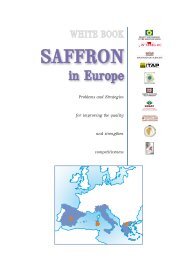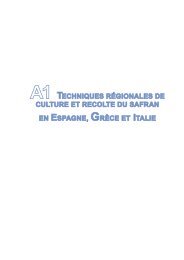Annex White book.pdf
Annex White book.pdf
Annex White book.pdf
You also want an ePaper? Increase the reach of your titles
YUMPU automatically turns print PDFs into web optimized ePapers that Google loves.
In Castile-La Mancha, the wet stigmas are spread out in a layerof less than 22 cm, on metal or silk sieves. The sieves are placed on aheating source. The most common heating sources for saffron dryingnowadays are fire, butane gas ovens or coal from vines. Other heatingsources, though seldom used, are wooden drying plants, electricbraziers, heater coils and air heaters. The drying temperature shouldalways be above 70 o C and is applied for almost half an hour. Followingfeatures define the drying condition of saffron: feel, color, aromaand appearance. Optimized humidity is approximately at 10%, so thatthe packaging process should not stress the product and make extrawetting necessary.Sieve used in Castile-La Mancha for the drying of stigmas(UCLM)In Western Macedonia, stigmas are laid out on silk sieves in acontrolled temperature environment of 25 to 30 o C for 12 to 24 hours.Achieved optimized humidity for the final product varies between 10and 20%. The saffron is dry as long as it can be easily detached fromthe surface of the sieve.In Sardinia¸ “feidatura” is prior to drying and consists in wetting thestigmas with extra virgin olive oil (a quarter of a tea spoon for 100 gr ofwet saffron). It is said that “feidatura” improves stigma appearance and126




